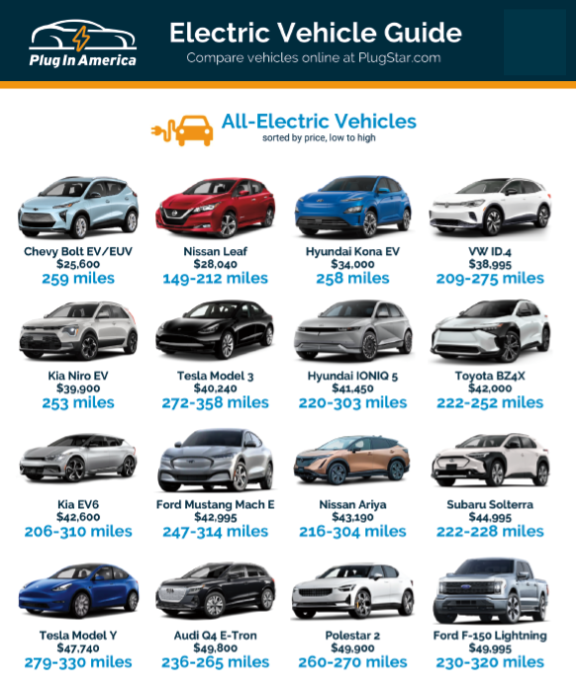
Electric Cars
Benefits of Electric Cars
EVs are the best car choice for our planet and our communities
No tailpipe emissions means cleaner air and healthy communities
EVs come in all shapes and sizes
EVs are a smart investment with lower fuel and maintenance costs
Say goodbye to oil changes
Be proud of the car you drive
The Cost of Electric Cars
There are more electric models than ever, from economy to luxury. When picking your next set of wheels, consider the “total cost of ownership,” or what you’ll pay over the life of the car, not just the sticker price at the dealership. When you factor in lower maintenance and fuel costs, an EV can be a very smart choice.
EV motors have about 20 moving parts, while internal combustion engines have about 2,000, so there are fewer parts to fail and fewer trips to a mechanic. You’ll also pay less for electricity than you would at the pump.
The median EV driver could save more than $770 per year on annual fuel costs compared to a gasoline powered vehicle (Fleet Electrification Report).
EV drivers tend to spend about 60 percent less each year on fuel costs compared to drivers of gas-powered cars.
Charging stations at home or on the go
EV chargers come in different “levels,” which describe how quickly they will recharge an EV’s battery.
At home charging: how it works
Level 1 is the slowest type of charging equipment. Most EVs come with a Level 1 charger, which plugs right into your standard 120-volt wall outlet. Many people charge when they get home from work, so their EV is ready to go in the morning.
Level 2 chargers are faster, fully charging an average EV in 8 hours or less. Many EV drivers choose to install a Level 2 charger for their home to make charging more convenient. These chargers are more expensive and require a dedicated 240-volt outlet. But there are incentives to help cover the cost.
Public charging spots: how to find them
There are charging station locators that make it easy to spot where to grab some extra charge on the go. This interactive map, from the US Department of Energy allows you to search for stations, filter by charging type, and even find the stations along your route. PlugShare, has a sleek interface and a mobile app to help you find charging stations wherever you are.
Our region
has over 300 public charging stations!
Range of Electric Cars
The idea of getting stranded makes some people reluctant to give up their gas-powered car. But EV drivers will tell you they have rarely – if ever – ran out of charge. In the US, we drive an average of 27 miles per day, but most EVs on the market can go over 200 miles on a single charge. A little extra planning is all you need.
Charge at home overnight or while you park at one of hundreds of public charging stations in our area. Don’t start your day on E.
The average American drives 40 miles or less a day while the shortest-range EV has a range of 2.5x that.
Listen to your EV. It’ll tell you how many miles to empty you are.
Getting close? Slow down and shut off the heat or AC.
Types of Electric Cars
From compact sedans to rugged pickup trucks, EVs come in all shapes and sizes.
BEST: Battery Electric Vehicles (BEVs) - These cars are powered just by an electric battery, with no gasoline involved. BEVs run with zero tailpipe emissions and are fun to drive.
BETTER: Plug-in Hybrid Electric Vehicles (PHEVs) - These cars have a charging port and a gas tank. The electric battery is the primary power source for the car, but they can switch to gasoline when they run out of charge.
GOOD: Hybrid Electric Vehicles (HEVs) - These cars have a gas powered engine but use an electric motor to assist at slow speeds. Gas is still the primary fuel source.
Contact your local auto dealer to learn more about electric cars today!
FAQs
(Click to expand.)
-
While it is true that the manufacturing of EVs and lithium ion batteries creates carbon emissions, the total lifetime greenhouse gas emissions of an EV, battery included, is still lower than its combustion engine counterpart even when considering manufacturing emissions.
-
Charging time depends on the size of the vehicle’s battery and the level of charging. Some vehicles are charged on regular 120V outlets and can fully charge in 8-20 hours. At a Level 2 station most vehicles will be fully charged in 4-10 hours. A third level of charging is commonly known as DC Fast Charging, which will charge some EVs to 80 percent in roughly 30 minutes.
-
Check out a charging station locators, like PlugShare. Or find charging stations along your route using this interactive map.
-
Many local dealerships have new and used EVs available. Try a quick google search for “EV dealerships” or “EV test drives” in your area.
-
Yes, your EV range will decrease during cold winter months. The temperature and the model will dictate by how much.
-
Hills, speed, traffic, cargo, passengers, and climate settings all have an impact on range.
-
EV batteries tend to last somewhere between 10-20 years before they need replacement.
-
Plug-in hybrids have a bigger, rechargeable battery that can power the vehicle even at higher speeds.



